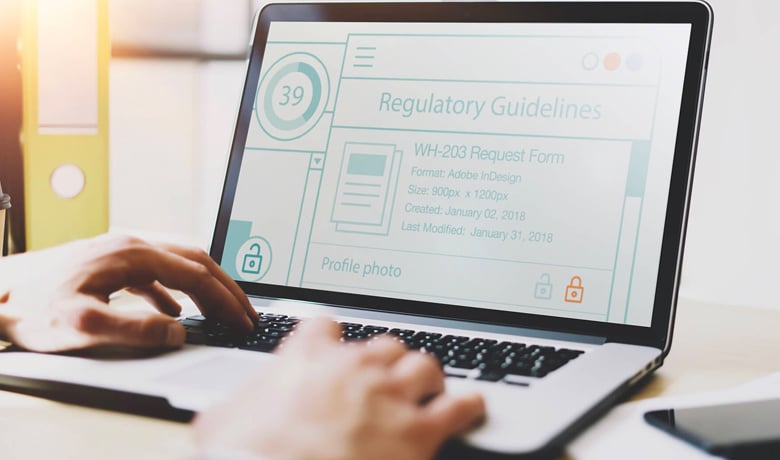
3 Strategies Used by Global Companies to Ensure Brand Compliance
3 Strategies Used by Global Companies to Ensure Brand Compliance https://stage2.marcom.com/wp-content/uploads/2019/12/img-regulatory-guidelines-blog.jpg 780 460 Matt Roberts Matt Roberts https://secure.gravatar.com/avatar/cf81e63968dadbf4b340f63f3f507e3f?s=96&d=mm&r=gWhen it comes to supplying global content, organizations that operate in multiple countries face a number of challenges.
You must preserve the integrity of your company’s image and its brand promise, no matter the corner of the globe an interaction is happening with a customer. Ensuring brand compliance for global brands is an important part of strategic corporate communications, and a powerful tool when used correctly.
Here are three strategies that winning, global companies deploy to ensure brand compliance.
- They define clear brand compliance standards
Angie Geffen, VP of Marketing for Perion Network describes the challenge for global brands in a recent post, saying:
“Many brands already market to different countries, but they tend to focus on individual countries rather than a global strategy. Therefore, they have multiple campaigns running, and each is operating independently. Each campaign is tailored to the specific country in question. However, those campaigns are not operating in conjunction with one another. They might as well be for different brands – they are so different and have absolutely nothing to do with one another.”
According to research by MarcomCentral and DemandMetric, when content is fragmented (for example, across countries,) it loses its ability to impact revenue generation by 11%. 85% of marketers with fragmented content assets think they’re “very poor” or “neutral” at meeting buyer needs.
Brand compliance is like taking a road trip. You need a map to get where you’re going.
Make sure brand compliance guidelines are well established throughout your team. Include examples and guidance for anyone creating content for your organization.
- They set up a centralized brand compliance resource
Another strategy used to keep branding on-point around the world is to leverage brand management software to aggregate resources into one cohesive tool used worldwide. A global marketing portal is an online, on-demand repository that helps corporate marketing departments empower large distributed teams with approved brand assets. It’s a key resource used to access, customize, and distribute marketing content in multi-cultural, multi-lingual environments.
It allows a corporate teams to control their brand while giving employees content when – and how – they need it. Without a marketing portal in place, employees tend to waste time searching for the right asset on shared drives, or often “going rogue” to create content like proposals, presentations, or brochures on their own. This creates a disjointed experience for customers, and can limit content effectiveness.
Marketing Asset Management (MAM) provides a corporate-controlled repository of digital assets and branded multi-channel templates (email, print, form capture, etc.). Local marketers can then customize and create brand-approved customized assets or campaigns that meet the needs of local target audiences. MAM empowers local marketers with autonomy and customization while maintaining brand consistency at a corporate level.
When all offices can access, localize and distribute the latest marketing materials, they’re empowered to ensure all customers have a cohesive experience with a brand, as every touchpoint is on-brand and up-to-date.
A marketing portal allows companies to efficiently scale, doing business globally while marketing locally, by giving all employees and partners fast access to materials that can be customized within pre-approved guidelines.
- They customize at the local level
Organizations with a large team of field reps often benefit from the sheer size of their labor force. Their efforts help to keep global or national organizations growing.
Unfortunately, it can become increasingly difficult for centralized marketing teams to distribute enough approved, customized content to such a large amount of reps in the field. Marketing is often pushed beyond their capacity when asked to provide custom marketing materials for these distinct regions or other factions on a regular basis.
Yet, field reps know as well as we do, that 90% of consumers find custom content useful. When content is relevant and personalized to a buyer, it is far more effective. 70% of survey participants who personalize most of their content report they’re able to support customers on their buying journeys.
It’s no surprise why 91% of Top Performers in a Gleanster study cited the need to “increase relevance and personalization in localized markets” as the top reason to invest in Marketing Asset Management.
Ultimately, global brand compliance is about consistency.
Tim Calkins, Clinical Professor of Marketing at the Kellogg School of Management at Northwestern University, sums it up perfectly:
He defines consistency as “getting an entire organization to embrace the brand and live up to the brand promise over time. Brands are created through a wide range of touch points; every time customers interact with a brand they form associations. Consistency matters, and it matters at every turn.”
(No matter where in the world your customers are!)
SEE HOW A SELF-SERVE MARKETING PORTAL CAN HELP SCALE YOUR BUSINESS
- Posted In:
- MarcomCentral




